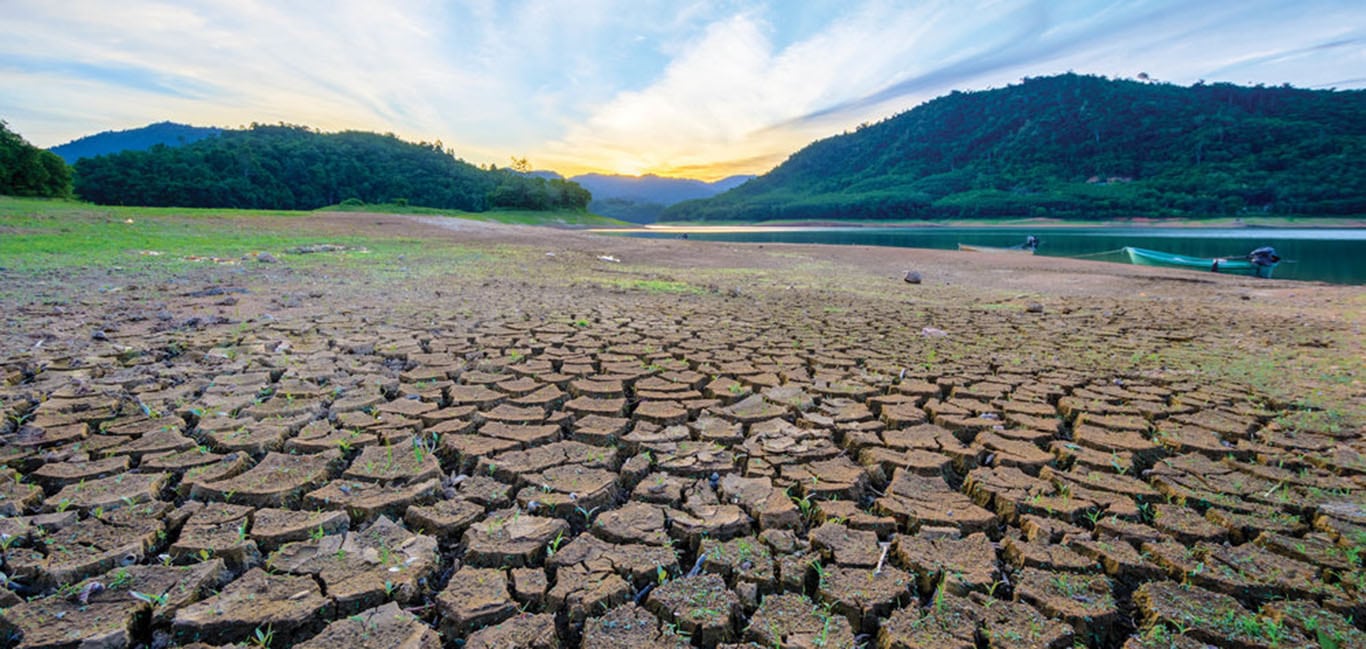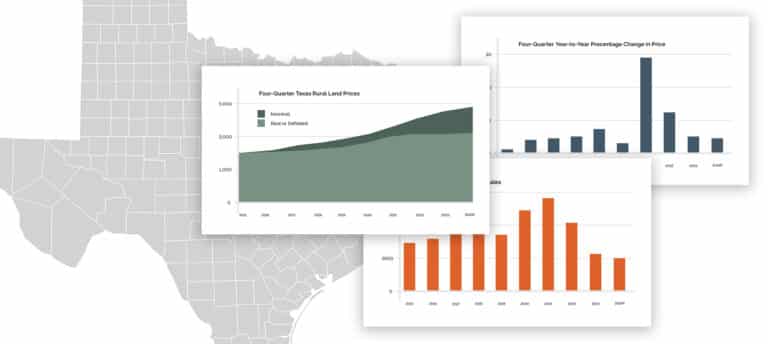The statewide rains in August ensured that Texas, with 75.25 inches, had just enjoyed the wettest 24-month consecutive period in its history. While the life-giving moisture was needed and welcomed, it muddied the memory of 2011, when Texas, with an average of 14.18 inches, struggled to survive its driest year ever.
In the midst of the most recent drought that stretched from 2010 well into 2014, water—or lack thereof—was on people’s minds and at the heart of heated policy debates. The drought highlighted a side effect of Texas’ rapid population growth. Our demand for water—residential, industrial and agricultural—is on-track to quickly outstrip our supply.
It’s our job to leave the land better than we found it.
Water is not the only resource in high demand. The burgeoning population, which is 28.2 million now and expected to climb to 41.9 million by 2050, has an insatiable appetite for land.
“Texas is losing open space land faster than any other state in the nation,” Fitzsimons said.
At the moment, 25 million Texans live in metro areas while 3.2 million Texans live in non-metro areas. The urban/rural imbalance creates one more challenge. Fewer people have first-hand knowledge of ecological relationships including the connection between land and water.
“Quality and quantity of water are directly correlated to the quality and quantity of open space,” Fitzsimons said. “Healthy working lands filter run-off, which improves quality, and absorb the rain that falls to replenish groundwater and surface water sources.”
And as the spring floods pointed out, rangeland plays a critical role when water rages.
“Land fragmentation with great development leads to greater run-off,” Neal Willkins, president and CEO of the East Foundation based in San Antonio, said. “Healthy intact areas of native rangeland act like a sponge, slowing run-off and keeping rivers from flooding in one big, catastrophic pulse.”
Raising public awareness of the land-water connection is the impetus behind TALT’s “No Land, No Water” campaign.
“Bringing the issues that will affect the future of Texas to the attention of Texans is one part of what TALT does,” Fitzsimons said. “Unchecked land fragmentation means no land which means no water which means no life. It seems self-evident, but for many people it’s not.”
In addition to raising public awareness of the importance of open space, TALT, as an ag-focused land trust, provides landowners with a tool that allows them to conserve their private property in perpetuity.
“In the most literal sense, a conservation easement is a perpetual restriction that prohibits future development and non-agricultural commercial uses, while allowing landowners to continue doing what they do, whether it’s grazing, growing cotton or running a hunting operation,” said Fitzsimons. “In application, though, a conservation easement is often a land steward’s expression of their love of the land, enacted because they can’t bear the thought of their property being broken up.”
Conservation easements, which are tailored to each property, can be created to protect different natural assets ranging from endangered species and water sources to open space and productive agricultural lands.
“There is no one-size-fits-all conservation easement,” Fitzsimons said. “They’re as individual as the landowners who create them and the ranches they protect. The commonality? Conserving the land is good for wildlife, it’s good for water and it’s good for the future of Texas.”
Read on to see how three different landowners used conservation easements to protect the land—and the water—in their care.
Conserving Land Today = Water Security Tomorrow
Case Study 1: Sycamore Springs Ranch
Ruthie Russell began taking her sons camping on the family’s ranches before they were old enough to walk. Today, William and McLean, who are in their early 30s both, are committed outdoorsmen and part of the decision-making team that enacted a conservation easement on the family’s Sycamore Springs Ranch in Val Verde County. Situated on the northern border of the Devil’s River State Natural Area, the almost 7,700-acre ranch contains both Sycamore Springs and three miles of Devil’s River frontage. Together, the properties create a land holding that is large enough to be ecologically significant.
“The Devil’s River is too perfect to leave its fate to chance,” said Ruthie, who was the initial driving force behind the conservation easement on the Sycamore Springs Ranch. “The conservation easement formalized our commitment to keeping the river and the land pristine and wild. My sons, who now own the ranch, share my pride in our stewardship. There are few things better than conserving unique, important land for the future.”
Ruthie chose to enact a conservation easement because of the growing pressure of land fragmentation, which is hitting the Trans-Pecos particularly hard. According to the Texas A&M Institute of Renewable Natural Resources, the region lost a total of 10 percent of its farms and ranches greater than 2,000 acres between 1997 and 2007.
“Although this region is considered to be remote, it is not immune to the march of subdivisions and ranchettes,” Ruthie said. “Ranchettes make it difficult to conserve land on the scale necessary to keep habitat intact and ecological systems functioning. My ultimate goal was to pass the ranch along to the boys intact, so it would continue to make an ecological difference.”
The ranch lies at the juncture of the Tamaulipan, Balconian and Chihuahuan desert ecoregions, meaning that the plant community is diverse, changing from canyon to canyon, and ranging from giant live oaks and pecan trees to desert cactus and ocotillos. The diverse habitat, combined with the phenomenon of water in the desert, attracts abundant wildlife including white-tailed deer, Rio Grande turkey, javelina, scaled quail, waterfowl and white-wing and mourning doves as well rare species such black-capped vireos, golden eagles, peregrine falcons and the Devil’s River minnow.
“The water here is turquoise and crystal clear,” Ruthie said. “As my sister said when she saw it for the first time, ‘It looks just like the Mediterranean.’ Water in the desert is rare and special under any circumstances, but this is spectacular.” In addition to Sycamore Springs, the ranch is home to three additional springs, each has its own unique character, she said.
“My family believes in the importance of productive, open space land for both agriculture and the environment,” Ruthie said. “It’s a lesson that we learned from my grandparents who began acquiring our family land in the 1930s. My grandmother always said, ‘It’s our job to leave the land better than we found it.’ And then she’d take us out adventuring to see the splendor of nature first-hand.”
To that end, the family has worked with recognized naturalist David Bamberger to increase the number of rare Texas snowbells on the ranch and have created a partnership with Texas State University to offer on-site outdoor classes for its students. The first class, led by Dr. Timothy Bonner, a noted expert in riparian systems, allowed 14 students to study the microenvironment of the Devil’s River and gain an appreciation of the natural world.
“While my family is committed to doing its part to conserve land, we recognize that we can’t do it alone,” she said. “Young people from all walks of life have to be exposed to the miracle of the land, if they are going to understand it and value it.”
She continued, “Open space land nourishes the soul. Unfortunately, I’m afraid people won’t realize how land sustains them, until it’s gone. Imagine getting in your car, driving for 200 miles and seeing nothing but houses and strip malls. We would all die of sadness.”
Case Study 2: Holly Farms
No Land. No Water. For Mary Ruth Rhodenbaugh, owner of Holly Farms in Brazoria County, these words are more than just a slogan on a decal; they are a fact of life.
“When rain falls it has to have some place to land,” Rhodenbaugh, who is a former teacher and retired employee of Dow Chemical, said. “I’m not picking on developers or industries because I appreciate the need for both, but when rain falls on concrete it has a hard time soaking into the ground and replenishing our drinking water supplies.”
To do her part to keep her working lands open, Rhodenbaugh partnered with TALT to place a conservation easement on her 188-acre farm, which has been her family since 1908 when Rhodenbaugh’s grandparents, William and Juliet Brigance, established the homestead. It is located between the Brazos and San Bernard rivers in the San Bernard watershed.
The Brigances hoped to launch a dairy farm but the harsh realities of the climate quickly forced them to refocus their efforts on cotton, corn and cattle. Today, Holly Farms is a livestock and hay operation. In 2015, the farm was honored by the Texas Department of Agriculture as a Family Land Heritage property for being in continuous agricultural production for more than 100 years.
“The more open and receptive we keep the land, the more we can utilize rain to sustain the population of Texas,” Rhodenbaugh said.
The lifelong resident of Brazoria has watched the county, which borders Harris County and rapidly growing Houston, transition from sprawling farms and ranches to sub-divisions and strip malls. According to the Texas A&M Institute of Natural Resources, the Greater Houston/Coastal Bend area, of which Brazoria County is a part, has undergone some of the highest land fragmentation rates in the state.
“Water is something we need to pay attention to,” Rhodenbaugh said.
When Rhodenbaugh served as a Brazoria County Commissioner water for the future was one of her priorities. The rapidly growing county has already begun experiencing depleted supplies. Initially, her efforts got very little attention, but then Texas entered a period of extended drought. The obvious need allowed her to create a task force with representatives from agriculture, industry, environmentalists and municipalities.
“We were able to suggest practical things that would make a difference,” Rhodenbaugh said. “Now, we’re back in a wet season and it’s hard to convince people we need to conserve—and consider the future.”
With her eyes firmly on the future, Rhodenbaugh brings her message of water and land to Texas’ youngest citizens. She regularly speaks to pre-K, kindergarten and first grade classes about the importance of conserving natural resources.
“You have to get them early in their lives to help them understand that conservation is important for all of our lives,” Rhodenbaugh said.
She chose TALT to hold the easement because “an ag-friendly land trust was the best solution for me.” Her family has embraced the notion.
“This is not a big project for TALT or big by Texas standards, but I hope it will be example of what can be done on smaller acreages,” Rhodenbaugh said. “It doesn’t have to be 10,000 acres to be important. We’re conserving land—and it all matters.”
Case Study 3: Herff Farms
Throughout history, Cibolo Creek has been an important water source. The first to name it were the Coahuiltecan Indians, who dubbed it “Xoloton.” Beginning in 1691, it appears in the records of Spanish explorers, who called it various things, until 1721 when Marqués de San Miguel de Aguayo identified it as “Arroyo del Cibolo” or “Río Cibolo.” The name stuck and became a landmark identifier throughout the region. Many local institutions bear its name including the Cibolo Nature Center and Farm.
“As a child growing up in the Hill Country, I knew Cibolo Creek was beautiful, but I didn’t understand it was important,” said Carolyn Chipman Evans, executive director of the Cibolo Nature Center and Farm in Boerne.
Cibolo Creek rises 10 miles northwest of Boerne in southwestern Kendall County and runs southeast for 100 miles, forming the Bexar-Comal and the Bexar-Guadalupe county lines and crossing Wilson County, to its mouth on the San Antonio River, five miles northwest of Karnes City in Karnes County.
“Although it was part of my life, I didn’t understand its connection to my life until I had the opportunity to learn from a host of researchers who have come in and out of the Nature Center through the years,” Evans said.
Cibolo Creek provides critical recharge to the Edwards and Trinity aquifers; therefore, is responsible, in part, for the quality and quantity of drinking water for the surrounding region including San Antonio and Austin.
The realization of Cibolo Creek’s importance to the health and well-being of the entire region was a major factor that motivated the Friends of Cibolo Wilderness, Inc. to enact a conservation easement, held by TALT, on the Herff Farm, a 60-acre farm located in the riparian area of Cibolo and Menger creeks. The farm, founded in 1854 by Dr. Ferdinand Herff, a German immigrant physician, is adjacent to the Nature Center. It is one of the earliest working farms in the region.
“The farm was ripe for development,” Evans said. “We knew a development would irreparably damage the watershed and the overall atmosphere of the Nature Center and adjoining preserve. The staff and board of directors went through hell and brimstone to raise the money and purchase the property.”
As the board was working to acquire the property, a project that began in 1999, the population of Boerne exploded, increasing by 87 percent between 1997 and 2014. The population growth increased demand on local water supplies and exacerbated the ongoing land fragmentation.
“Conserving Herff Farm fits into the overall goals of the Nature Center,” Evans said. “We advocate and we educate.”
With the addition of Herff Farm to the land already conserved as part of the Nature Center and the Cibolo Preserve, almost 800 acres in one of the state’s fastest growing areas has been protected from future development.
“Having raw wild land is not just pretty, but it is critically important to our survival,” Evans said. “Most people don’t get the connection between the water and the land. Once you understand the link, it seems obvious but it’s obscure until you’re taught. We now have another place to teach.”
The combination of water and knowledge is a gift that will keep giving for generations.
“Forever protecting this property, its history and its resources was the most generous gift we could give to the community and the region,” Evans said.
TALT’s History
Texas is losing productive, open space land faster than any other state in the nation. While suburbanization plays a role in rural land loss, fragmentation is also a serious threat. As large properties are divided into smaller parcels they can no longer support agriculture. Fragmentation leads to loss of wildlife habitat, water quality problems, and higher demand for county services.
To address this challenge, American Farmland Trust, a national non-profit, in November 2005 brought together leaders of Texas’ statewide agricultural, wildlife and landowner organizations. The group concluded that a Texas agricultural land trust, created by landowners who understand the day-to-day challenges of farming and ranching, will help stem the irreversible loss of rural lands.
Leaders from Texas & Southwestern Cattle Raisers Association, Texas Wildlife Association and Texas Farm Bureau convened a steering committee, and drafted by-laws and a certificate of incorporation. In developing the philosophy, mission and principles for the new land trust, careful attention was given to recognizing the landowner’s property rights and to ensuring that those rights will not erode over time.
The result was the creation of the Texas Agricultural Land Trust (TALT), a Texas non-profit organization. Modeled on agricultural land trusts in Colorado, Wyoming and California, TALT promotes the conservation of open space, wildlife habitats, and natural resources on Texas’ private working lands. Governed by a Board of Directors comprised of men and women who own land themselves, TALT today has partnered with landowners to conserve more than 226,000 acres of prime working lands. Created by farmers and ranchers for farmers and ranchers, TALT is proud to play a role in conserving part of Texas’ legacy of wide open spaces.


